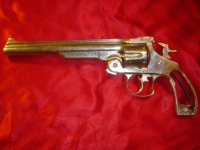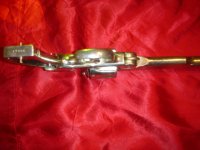Under the premise that "a little bit of knowledge is dangerous", please help me identify a family heirloom that I cannot find described exactly in any of my research to date. Here are the details:
Smith & Wesson Double Action
Barrell Length - 8 inches
Finish - Nickel
Caliber - .444" at front and rear cylinder chamber diameter (a .44 American cartridge?)
Cylinder Length - 1.423" (standard model?)
Barrel Patent Markings - *Smith & Wesson Springfield, Mass U.S.A. Pat. July 10, 60, Jan. 17, Feb. 17, July 11, 65 & Aug. 24, 69*
Extractor Drive - Square
Square Back Trigger Guard
Barrel Catch WITH interlock shelf
Serial Number - 17308
History: This has been in my family for a couple of generations. As a kid I wrote to S&W in 1967 for help in identifying the weapon. I remember sending them a pencil drawing without many detail (well before the age of email and jpeg). They sent me a return letter which I still have identifying my revolver as a "Model No. 3, First Model, 44 caliber, Single Action, Russian, which was manufactured from 1870 to 1875 in numbers from 1 to 215,705."
Current: While researching a book I am writing on Custer's troopers at the Little Bighorn, I pulled out the old relic just to "see" if maybe it "could" have been there...well, off course, despite S&W's assessment in 1967 from my unskilled drawing, it is a double action and wasn't made until at least five years after the battle, but it just doesn't seem to fit any of the photos in the Chicoine book or any on the internet of the Model No. 3 American...The cylinder doesn't seem to match the double action design, the front blade sight certainly doesn't match the standard half moon design (after market replacement), the extractor drive is square, etc, etc.
If its not a Model No. 3 American, First Model...what is it? What am I missing here? Any help appreciated...Thanks.
Smith & Wesson Double Action
Barrell Length - 8 inches
Finish - Nickel
Caliber - .444" at front and rear cylinder chamber diameter (a .44 American cartridge?)
Cylinder Length - 1.423" (standard model?)
Barrel Patent Markings - *Smith & Wesson Springfield, Mass U.S.A. Pat. July 10, 60, Jan. 17, Feb. 17, July 11, 65 & Aug. 24, 69*
Extractor Drive - Square
Square Back Trigger Guard
Barrel Catch WITH interlock shelf
Serial Number - 17308
History: This has been in my family for a couple of generations. As a kid I wrote to S&W in 1967 for help in identifying the weapon. I remember sending them a pencil drawing without many detail (well before the age of email and jpeg). They sent me a return letter which I still have identifying my revolver as a "Model No. 3, First Model, 44 caliber, Single Action, Russian, which was manufactured from 1870 to 1875 in numbers from 1 to 215,705."
Current: While researching a book I am writing on Custer's troopers at the Little Bighorn, I pulled out the old relic just to "see" if maybe it "could" have been there...well, off course, despite S&W's assessment in 1967 from my unskilled drawing, it is a double action and wasn't made until at least five years after the battle, but it just doesn't seem to fit any of the photos in the Chicoine book or any on the internet of the Model No. 3 American...The cylinder doesn't seem to match the double action design, the front blade sight certainly doesn't match the standard half moon design (after market replacement), the extractor drive is square, etc, etc.
If its not a Model No. 3 American, First Model...what is it? What am I missing here? Any help appreciated...Thanks.







